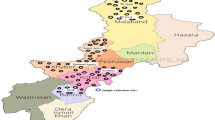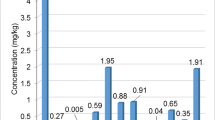Abstract
Honey is a nutritive fluid product of bees with an array of pharmacological/medicinal effects. As a natural product from honeybees, honey is regarded to be safe and free from any contaminants. Cassava tuber (Manihot esculenta)–based meal, Vernonia amygdalina (bitter leaf soup), and honey are common local cuisine in Nigeria. This is a human health risk assessment of heavy metals associated with the consumption of honey (Apis mellifera scutellata), cassava (Manihot esculenta), and bitter leaf (Vernonia amygdalina) in Enugu State, Nigeria. Concentrations of lead (Pb), Cd, As, Cu, Ni, Mn, Fe, Cr, and Fe in honey, soil, Manihot esculenta, and Vernonia amygdalina were determined using an atomic absorption spectrophotometer (AAS). The principal component analysis (PCA) was performed as a factor reduction technique among 12 factors (3 locations against 4 sources of heavy metals). The mean concentration of metals in honey, soil, Manihot esculenta, and Vernonia amygdalina ranged from 0.001 to 4.28 mg kg−1, from 0.0026 to 170.52 mg kg−1, from 0.012 to 80.63 mg kg−1, and from 0.0016 to 126.48 mg kg−1, respectively. Pb showed the highest carcinogenic risk with values of 3.18E−04–1.43E−01 in Vernonia amygdalina and 1.69E−04–3.47E−04 in Manihot esculenta for adults and children, respectively. In honey, Cd showed the highest carcinogenic risk with values of 1.26E−02–1.07E−01. About 51.5% of total cancer risk (TCR) was below 1E−04. Consumption of honey, Vernonia amygdalina, and Manihot esculenta in some urban parts of Enugu may pose some adverse health effects.


Similar content being viewed by others
References
Abboud, P., & Wilkinson, K. J. (2013). Role of metal mixtures (Ca, Cu and Pb) on Cd bioaccumulation and phytochelatin production by Chlamydomonas reinhardtii. Environmental Pollution, 179, 33–38.
Adedokun, O. M., Kyalo, M., Gnonlonfin, B., Wainaina, J., Githae, D., Skilton, R., & Harvey, J. (2016). Mushroom: molecular characterization of indigenous species in the Niger Delta Region of Nigeria. European Journal of Horticultural Science, 81(5), 273–280.
Adelekan, B. A. (2010). Investigation of ethanol productivity of cassava crop as a sustainable source of biofuel in tropical countries. African Journal of Biotechnology, 9, 5643–5650.
Altun, S. K., Dinç, H., Paksoy, N., TemamoLullar, F. K., & Savrunlu, M. (2017). Analyses of mineral content and heavy metal of honey samples from south and east region of Turkey by using ICP-MS. International Journal of Analytical Chemistry, 2017, 1–6. https://doi.org/10.1155/2017/6391454.
Amadi, C. N., Igweze, Z. N., & Orisakwe, O. E. (2017). Heavy metals in miscarriages and stillbirths in developing nations. Middle East Fertility Society Journal, 22(2), 91–100.
Bamuwamye, M., Ogwok, P., & Tumuhairwe, V. (2015). Cancer and non-cancer risks associated with heavy metal exposures from street foods: evaluation of roasted meats in an urban setting. Journal of Environment Pollution and Human Health, 3(2), 24–30.
Bellinger, D. C., Stiles, K. M., & Needleman, H. L. (1992). Low-level lead exposure, intelligence and academic achievement: a long-term follow-up study. Pediatrics, 90(6), 855–861.
Calderon, J., Ortiz-Perez, D., Yanez, L., & Díaz-Barriga, F. (2003). Human exposure to metals. Pathways of exposure, biomarkers of effect, and host factors. Ecotoxicology and Environmental Safety, 56, 93–103.
Cao, H., Qiao, L., Zhang, H., & Chen, J. (2010). Exposure and risk assessment for aluminum and heavy metals in Puerh tea. Science of the Total Environment, 408, 2777–2784.
Costanza, R., d’Arge, R., De Groot, R., Farber, S., Grasso, M., Hannon, B., Limburg, K., Naeem, S., O’Neill, R. V., Paruelo, J., & Raskin, R. G. (1997). The value of the world’s ecosystem services and natural capital. Nature, 387(6630), 253–260.
EFSA. (2008). Scientific opinion of the panel on contaminants in the food chain on a request from the European Commission on polycyclic aromatic hydrocarbons in food. EFSA Journal, 724, 1–114.
FAO/WHO. (2011). Evaluation of certain contaminants in food: seventy-second report of the joint FAO/WHO Expert Committee on Food Additives. WHO Technical Report Series No. 959. Geneva: World Health Organization.
Gallmann, P., Stefan, B., Tomislav, J., & Robert, S. (2009). Honey for nutrition and health: a review. Journal of the American College of Nutrition, 27, 677–689. https://doi.org/10.1080/07315724.2008.10719745.
Hague, T., Petroczi, A., Andrews, P. L., Barker, J., & Naughton, D. P. (2008). Determination of metal ion content of beverages and estimation of target hazard quotients: a comparative study. Chemistry Central Journal, 2(1), 13.
Hernández, O. M., Fraga, J. M. G., Jiménez, A. I., Jimenez, F., & Arias, J. J. (2005). Characterization of honey from the Canary Islands: determination of the mineral content by atomic absorption spectrophotometry. Food Chemistry, 93(3), 449–458.
Hu, X., Zhang, Y., Ding, Z. H., Wang, T. J., Lian, H. Z., & Sun, Y. Y. (2012). Bio accessibility and health risk of arsenic and heavy metals (Cd, Co, Cr, Cu, Ni, Pb, Zn and Mn) in TSP and PM2. Atmospheric Environment (Vol. 57, pp. 146–152).
Igbiri, S., Udowelle, N. A., Ekhator, O. C., Asomugha, R. N., Igweze, Z. N., & Orisakwe, O. E. (2017). Polycyclic aromatic hydrocarbons in edible mushrooms from Niger Delta, Nigeria: carcinogenic and non-carcinogenic health risk assessment. Asian Pacific Journal of Cancer Prevention, 18(2), 437.
Ioannidou, M. D., Zachariadis, G. A., Anthemidis, A. N., & Stratis, J. A. (2005). Direct determination of toxic trace metals in honey and sugars using inductively coupled plasma atomic emission spectrometry. Talanta, 65, 92–97.
Iwegbue, C. M., Obi-Iyeke, G. E., Tesi, G. O., Obi, G., & Bassey, F. I. (2015). Concentrations of selected metals in honey consumed in Nigeria. International Journal of Environmental Studies, 72(4), 713–722.
Jarup, L., (2003). Hazards of heavy metal contamination. Br. Med. Bull. 68, 167–182.\
Jolly, Y. N., Islam, A., & Akbar, S. (2013). Transfer of metals from soil to vegetables and possible health risk assessment. SpringerPlus, 2(1), 385.
Kalia, K., & Flora, S. J. (2005). Strategies for safe and effective therapeutic measures for chronic arsenic and lead poisoning. Journal of Occupational Health, 47, 1–21.
Komosinska-Vassev, K., Olczyk, P., Kaźmierczak, J., Mencner, L., & Olczyk, K. (2015). Bee pollen: chemical composition and therapeutic application. Evidence-Based Complementary and Alternative Medicine, 1–7.
Leblebici, Z. E. L. I. H. A., & Aksoy, A. H. M. E. T. (2008). Determination of heavy metals in honey samples from Central Anatolia using plasma optical emission spectrofotometry (ICP-OES). Polish Journal of Environmental Studies, 17(4), 549–555.
Li, Z., Zhuanga, P., McBride, M. B., Xiaa, H., & Lia, N. (2009). Health risk from heavy metals via consumption of food crops in the vicinity of Dabaoshan mine, South China. Science of the Total Environment, 407(5), 1551–1561.
Llobet, J. M., Falco, G., Casas, C., Teixido, A., & Domingo, J. L. (2003). Concentrations of arsenic, cadmium, mercury, and lead in common foods and estimated daily intake by children, adolescents, adults, and seniors of Catalonia, Spain. Journal of Agricultural and Food Chemistry, 51(3), 838–842.
NEPAC. (2005). Maximum levels of contaminants in food. Beijing, China: National Environmental Protection Agency of China.
Nwaogazie, I. L. (2011). Probability and statistics for science and engineering practice (pp. 125–126). Enugu: De-Adroit Innovation.
Oluwole, S. O., Makinde, O. S. C., Yusuf, K. A., Fajana, O. O., & Odumosu, A. O. (2013). Determination of heavy metal contaminants in leafy vegetables cultivated by the road side. International Journal of Engineering Research and Development, 7(3), 1–5.
Orisakwe, O. E., Nduka, J. K., Amadi, C. N., Dike, D. O., & Bede, O. (2012). Heavy metals health risk assessment for population via consumption of food crops and fruits in Owerri, South Eastern, Nigeria. Chemistry Central Journal, 6, 77.
Orisakwe, O. E., Blum, J. L., Sujak, S., & Zelikoff, J. T. (2014). Metal pollution in Nigeria: a biomonitoring update. Journal of Health Pollution, 4(6), 40–52.
Orisakwe, O. E., Igweze, Z. N., & Udowelle, N. A. (2019). Candy consumption may add to the body burden of lead and cadmium of children in Nigeria. Environmental Science and Pollution Research, 26(2), 1921–1931.
Osu, S. R., Solomon, M. M., Abai, E. J., & Etim, I. G. (2015). Human health risk assessment of heavy metals Intake via cassava consumption from crude oil impacted soils with and without palm bunch ash additive. International Journal of Technical Research and Applications, 3(4), 140–148.
Ozoani, H. A.. (2018). Human health risk assessment of heavy metal and polycyclic aromatic hydrocarbons (PAHs) in honey, cassava and bitter leaf from Enugu State, Nigeria. MSc thesis. Faculty of Pharmacy, University of Port Harcourt. Nigeria
Rehman, K., Fatima, F., Waheed, I., & Akash, M. S. H. (2018). Prevalence of exposure of heavy metals and their impact on health consequences. Journal of Cellular Biochemistry, 119(1), 157–184.
Silici, S., Uluozlu, O. D., Tuzen, M., & Soylak, M. (2008). Assessment of trace element levels in Rhododendron honeys of Black Sea Region, Turkey. Journal of Hazardous Materials, 156(1–3), 612–618.
Singh, A., Sharma, R. K., Agrawal, M., & Marshall, F. M. (2010). Risk assessment of heavy metal toxicity through contaminated vegetables from waste water irrigated area of Varanasi, India. Tropical Ecology, 51(2), 375–387.
Sitarz-Palczak, E., Kalembkiewicz, J., & Galas, D. (2015). Evaluation of the content of selected heavy metals in samples of Polish honeys. Journal of Ecological Engineering, 16(3), 130–138.
Steenland, K., Boffetta, P. (2000). Lead and cancer in humans: where are we now? Am. J. Ind. Med. 38, 295–299
Underwood, E. J. (1977). Trace elements in human and animal nutrition (4th ed.). New York: Academic.
US EPA (1989) (United States Environmental Protection Agency)Risk assessment guidance for superfund. Human Health Evaluation Manual (Part A). Interim Final, vol. I, United States Environmental Protection Agency, Washington (DC) EPA/540/1-89/002
USEPA (2000) Supplementary guidance for conducting health risk assessment of chemical mixtures. Risk Assessment Forum Technical Panel [EPA/630/R-00/002].
USEPA. (2005). The limits of pollutants in food. China: State Environmental Protection Administration.
WHO (1991) International Programme on Chemical Safety. Environmental Health Criteria, Vol. 108, Geneva, p. 286.
WHO (1992). Cadmium. Environmental Health Criteria, Geneva. Vol. 134.
Xia, Z. H., Duan, X. L., Qiu, W. X., Liu, D., Wang, B., Tao, S., Jiang, Q. J., Lu, B., Song, Y. X., & Hu, X. X. (2010). Health risk assessment on dietary exposure to polycyclic aromatic hydrocarbons (PAHs) in Taiyuan, China. Science of the Total Environment, 408, 5331–5337.
Zhan, X., Liang, X., Jiang, T., & Xu, G. (2013). Interaction of phenanthrene and potassium uptake by wheat roots: a mechanistic model. BMC Plant Biology, 13(1), 1–9.
Author information
Authors and Affiliations
Corresponding author
Additional information
Publisher’s note
Springer Nature remains neutral with regard to jurisdictional claims in published maps and institutional affiliations.
Rights and permissions
About this article
Cite this article
Orisakwe, O.E., Ozoani, H.A., Nwaogazie, I.L. et al. Probabilistic health risk assessment of heavy metals in honey, Manihot esculenta, and Vernonia amygdalina consumed in Enugu State, Nigeria. Environ Monit Assess 191, 424 (2019). https://doi.org/10.1007/s10661-019-7549-2
Received:
Accepted:
Published:
DOI: https://doi.org/10.1007/s10661-019-7549-2




